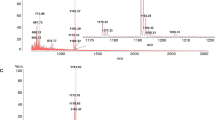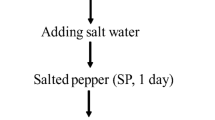Abstract
Analysis of the dipicolinic acid (DPA) released from Clostridium botulinum spores during thermal processing is crucial to obtaining a mechanistic understanding of the factors involved in spore heat resistance and related food safety applications. Here, we developed a novel mixed-mode liquid chromatography-tandem mass spectrometry (LC–MS/MS) method for detection of the DPA released from C. botulinum type A, nonproteolytic types B and F strains, and nonpathogenic surrogate Clostridium sporogenes PA3679 spores. DPA was retained on a mixed-mode C18/anion exchange column and was detected using electrospray ionization (ESI) positive mode within a 4-min analysis time. The intraday and interday precision (%CV) was 1.94–3.46% and 4.04–8.28%, respectively. Matrix effects were minimal across proteolytic type A Giorgio-A, nonproteolytic types QC-B and 202-F, and C. sporogenes PA3679 spore suspensions (90.1–114% of spiked DPA concentrations). DPA recovery in carrot juice and beef broth ranged from 105 to 118%, indicating limited matrix effects of these food products. Experiments that assessed the DPA released from Giorgio-A spores over the course of a 5-min thermal treatment at 108 °C found a significant correlation (R = 0.907; P < 0.05) between the log reduction of spores and amount of DPA released. This mixed-mode LC–MS/MS method provides a means for rapid detection of DPA released from C. botulinum spores during thermal processing and has the potential to be used for experiments in the field of food safety that assess the thermal resistance characteristics of various C. botulinum spore types.
Graphical abstract




Similar content being viewed by others
Abbreviations
- DPA:
-
Dipicolinic acid
- ESI:
-
Electrospray ionization
- LC-MS:
-
Liquid chromatography-mass spectrometry
- MS:
-
Mass spectrometry
References
Peck MW, van Vliet AH. Impact of Clostridium botulinum genomic diversity on food safety. Curr Opin Food Sci. 2016;10:52–9.
Åberg AT, Karlsson I, Hedeland M. Modification and validation of the Endopep-mass spectrometry method for botulinum neurotoxin detection in liver samples with application to samples collected during animal botulism outbreaks. Anal Bioanal Chem. 2021;413(2):345–54.
Church BD, Halvorson H. Dependence of the heat resistance of bacterial endospores on their dipicolinic acid content. Nature. 1959;183(4654):124–5.
Margosch D, Ehrmann MA, Gänzle MG, Vogel RF. Comparison of pressure and heat resistance of Clostridium botulinum and other endospores in mashed carrots. J Food Prot. 2004;67(11):2530–7.
Akasaka K, Maeno A, Yamazaki A. Direct high-pressure NMR observation of dipicolinic acid leaking from bacterial spore: a crucial step for thermal inactivation. Biophys Chem. 2017;231:10–4.
Lenz CA, Reineke K, Knorr D, Vogel RF. High pressure thermal inactivation of Clostridium botulinum type E endospores – kinetic modeling and mechanistic insights. Front Microbiol. 2015;6:652.
Buiarelli F, Sonego E, Uccelletti D, Bruni E, Di Filippo P, Pomata D, Riccardi C, Perrino C, Marcovecchio F, Simonetti G. Determination of the main bioaerosol components using chemical markers by liquid chromatography–tandem mass spectrometry. Microchem J. 2019;149:103974.
Di Filippo P, Pomata D, Riccardi C, Buiarelli F, Uccelletti D, Zanni E. Muramic and dipicolinic acids in atmospheric particulate matter as biomarkers of bacteria and bacterial spores. Anal Bioanal Chem. 2017;409(6):1657–66.
Gonzalez LE, Szalwinski LJ, Marsh BM, Wells JM, Cooks RG. Immediate and sensitive detection of sporulated Bacillus subtilis by microwave release and tandem mass spectrometry of dipicolinic acid. Analyst. 2021;146(23):7104–8.
McCalley DV. Managing the column equilibration time in hydrophilic interaction chromatography. J Chromatogr A. 2020;1612:460655.
Alpert AJ. Effect of salts on retention in hydrophilic interaction chromatography. J Chromatogr A. 2018;1538:45–53.
Krivoshein AV, Ermolenkov VV. The persistent ‘memory effect’ of triethylamine in atmospheric pressure ionization sources can be effectively controlled by decontamination with a iPrOH/AcOH mixture. Rapid Commun Mass Spectrom. 2018;32(10):824–6.
Choi MS, Rehman SU, Kim IS, Park H-J, Song M-Y, Yoo HH. Development of a mixed-mode chromatography with tandem mass spectrometry method for the quantitative analysis of 23 underivatized amino acids in human serum. J Pharm Biomed Anal. 2017;145:52–8.
Zhang K, Liu X. Mixed-mode chromatography in pharmaceutical and biopharmaceutical applications. J Pharm Biomed Anal. 2016;128:73–88.
Sýkora D, Řezanka P, Záruba K, Král V. Recent advances in mixed-mode chromatographic stationary phases. J Sep Sci. 2019;42(1):89–129.
Sheth AN, Wiersma P, Atrubin D, Dubey V, Zink D, Skinner G, Doerr F, Juliao P, Gonzalez G, Burnett C. International outbreak of severe botulism with prolonged toxemia caused by commercial carrot juice. Clin Infec Dis. 2008;47(10):1245–51.
Peck MW, Webb MD, Goodburn KE. Assessment of the risk of botulism from chilled, vacuum/modified atmosphere packed fresh beef, lamb and pork held at 3 °C–8 °C. Food Microbiol. 2020;91:103544.
Reddy NR, Marshall KM, Morrissey TR, Loeza V, Patazca E, Skinner GE, Krishnamurthy K, Larkin JW. Combined high pressure and thermal processing on inactivation of type A and proteolytic type B spores of Clostridium botulinum. J Food Prot. 2013;76(8):1384–92.
Skinner GE, Morrissey TR, Patazca E, Loeza V, Halik LA, Schill KM, Reddy NR. Effect of high pressures in combination with temperature on the inactivation of spores of nonproteolytic Clostridium botulinum types B and F. J Food Prot. 2018;81(2):261–71.
U.S. Food and Drug Administration. Bacteriological manual, revision A. 8th ed. AOAC International, Gaithersburg; 1998.
Reddy N, Tetzloff R, Skinner G. Effect of media, additives, and incubation conditions on the recovery of high pressure and heat-injured Clostridium botulinum spores. Food Microbiol. 2010;27(5):613–7.
Lynt R, Solomon H, Lilly T Jr, Kautter D. Thermal death time of Clostridium botulinum type E in meat of the blue crab. J Food Sci. 1977;42(4):1022–5.
Yang J, Rainville PD. Analysis of organic acids using a mixed-mode LC column and an ACQUITY QDa mass detector. Waters Co. 2021. https://www.waters.com/content/dam/waters/en/app-notes/2020/720006938/720006938-en.pdf. Accessed 07 JAN 2022.
AOAC International. AOAC guidelines for single laboratory validation of chemical methods for dietary supplements and botanicals. 2002. https://members.aoac.org/AOAC_Docs/StandardsDevelopment/SLV_Guidelines_Dietary_Supplements.pdf. Accessed 11 AUG 2021.
Goodacre R, Shann B, Gilbert RJ, Timmins EM, McGovern AC, Alsberg BK, Kell DB, Logan NA. Detection of the dipicolinic acid biomarker in Bacillus spores using Curie-point pyrolysis mass spectrometry and Fourier transform infrared spectroscopy. Anal Chem. 2000;72(1):119–27.
March RE, Stadey CJ, Lewars EG. Pyridine N-oxide and pyridine-d5 N-oxide: an electrospray/tandem mass spectrometric study carried out at high mass resolution. Rapid Commun Mass Spectrom. 2005;19(8):984–1004.
de Oliveira SM, de Giovani WF, Romero JR, Miller J. Mass spectra of picolinic, nicotinic and isonicotinic acids and of their respective N-oxides. J Mass Spectrom. 1991;26(10):855–6.
Furey A, Moriarty M, Bane V, Kinsella B, Lehane M. Ion suppression; a critical review on causes, evaluation, prevention and applications. Talanta. 2013;115:104–22.
Fichtel J, Köster J, Scholz-Böttcher B, Sass H, Rullkötter J. A highly sensitive HPLC method for determination of nanomolar concentrations of dipicolinic acid, a characteristic constituent of bacterial endospores. J Microbiol Methods. 2007;70(2):319–27.
Rattray JE, Chakraborty A, Li C, Elizondo G, John N, Wong M, Radović JR, Oldenburg TB, Hubert CR. Sensitive quantification of dipicolinic acid from bacterial endospores in soils and sediments. Environ Microbiol. 2021;23(3):1397–406.
Lomstein BA, Jørgensen BB. Pre-column liquid chromatographic determination of dipicolinic acid from bacterial endospores. Limnol Oceanogr Methods. 2012;10(4):227–33.
Fichtel J, Sass H, Rullkötter J. Assessment of spore contamination in pepper by determination of dipicolinic acid with a highly sensitive HPLC approach. Food Control. 2008;19(10):1006–10.
Funding
The research described in this publication is supported by the Food and Drug Administration (FDA) of the U.S. Department of Health and Human Services (HHS) as part of an award totaling $4,148,332 with 0% financed with non-governmental sources. The contents are those of the authors and do not necessarily represent the official views of, nor an endorsement, by FDA, HHS, or the U.S. Government. For more information, please visit FDA.gov.
Author information
Authors and Affiliations
Corresponding author
Ethics declarations
Conflict of interest
The authors declare no competing interests.
Additional information
Publisher’s note
Springer Nature remains neutral with regard to jurisdictional claims in published maps and institutional affiliations.
Rights and permissions
About this article
Cite this article
Redan, B.W., Morrissey, T.R., Rolfe, C.A. et al. Rapid detection and quantitation of dipicolinic acid from Clostridium botulinum spores using mixed-mode liquid chromatography-tandem mass spectrometry. Anal Bioanal Chem 414, 2767–2774 (2022). https://doi.org/10.1007/s00216-022-03926-7
Received:
Revised:
Accepted:
Published:
Issue Date:
DOI: https://doi.org/10.1007/s00216-022-03926-7




